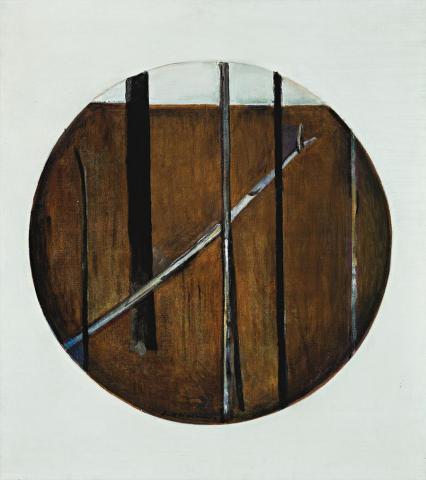FALLEN TREE, 1966
FRED WILLIAMS
oil on canvas
90.0 x 80.0 cm
signed lower centre: Fred Williams
Rudy Komon Gallery, Sydney (stock number 1504)
Bruce Gyngell, Sydney, acquired from the above in 1968
Geoff K. Gray, Sydney, March 1987
Niagara Galleries, Melbourne
Private collection, Sydney
Charles Nodrum Gallery, Melbourne
Private collection, Melbourne, acquired from the above in 1999
Dealer's Choice Exhibition, Rudy Komon Gallery, January 1968
Fallen Tree, 1968, oil on canvas, 122.5 x 122.5 cm, Private collection, illus. in Hart, D., Fred Williams: Infinite Horizons, National Gallery of Australia, Canberra, 2011, p. 215
Fallen Tree, 1967, etching, illus. in Mollison, J., Fred Williams: Etchings, Rudy Komon Gallery, Sydney, 1968, cat. 246
In Fred Williams's Fallen Tree, 1966, harmonies of dominant verticals transversed by the individuality of the single angle are under the command of the horizontal, encompassed within the circle. It is the visual equivalent of a series of beautiful sounds, abstracted from nature where inspiration was found. As with Williams's landscapes, it is a singular work of art, arresting in directness and seeming simplicity in its exploration of the profound. A tall tree has fallen between the trunks of other gums. The landscape climbs upwards behind to reach the horizon and a clear sky. Landforms emerge through the colour application of paint; and textures give bark to the gums. The subject would seem ordinary and everyday, not the stuff from which great art is made. But in the hands of Williams such things become so. Looking at this transcript of Australian landscape, it is this awareness that marks the beginning of an engrossing journey of aesthetic pleasure. It is like the excitement of the first captivating notes of a concerto, the seeing of sound and the sound of seeing. Unique to the created work itself, analogies are merely means of guidance.
Turning from the once perceived monotony of fields and forests of eucalypts, Williams painted melodies of nuanced colour, textured, encrusted paint, of detail touching the universal. As often observed, Williams discovered new variety and beauty in the sameness of the Antipodes. Superbly minimal as are his works of this time, the interplay between the classic flatness of the picture plane and the illusion of depth is Williams at his best. While trunks recede in ordered recession, the dominance of those on the picture surface keep the rightful order in its place. Then one falls sideways into the picture space, creating an illusion of depth. The tug-of-war between surface and depth continues in vertical immobility versus angular movement. It fascinated Williams and he explored it in a number of earlier works known as 'The Forest Series' of 1961-62, and especially an oil of 1962 of the same title, not as close in focus, with the fallen tree leaning the other way.1 The later Fallen Tree of 1968 (private collection) is almost identical to our painting, also circular of composition, and included in the recent Fred Williams retrospective at the National Gallery of Australia. The etching Fallen Tree, 1967 is close in imagery, impressions being in the best collections. Remarking on the monotony of the Australian landscape and lack of a focal point, Williams said, '... if there's going to be no focal point in a landscape [then] it had to [be built] into the paint'. Here, the circle itself creates that focal point.
1. Fallen Tree, 1962, oil on composition board, 90 x 121 cm, private collection, illus. in McCaughey, fig. 129, p.142. See also Fallen Tree, 1962, watercolour and gouache, 37.5 x 49 cm, Art Gallery of New South Wales, Sydney
2. Fred Williams to James Gleeson, interview 3 October 1978 for Australian National Gallery Interview Series, quoted in Zdanowicz, I., and Coppel, S., Fred Williams: An Australian Vision, The British Museum Press, London, 2003, p. 77
DAVID THOMAS
